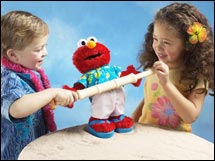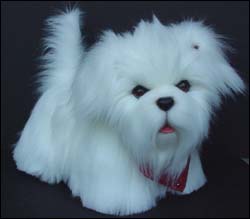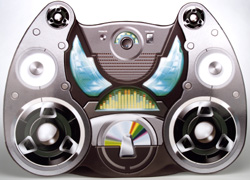NEW YORK (CNN/Money) -
After a long week of pondering war and Wall Street, it's time to bring out the toy chests as the 100th anniversary edition of the International Toy Fair begins this weekend in New York City.
The business of toys hasn't been all that fun lately, and it appears that the industry is looking to the past to answer its most pressing need -- the "must-have" hot toy for 2003.
"The toy industry has really been flat for the past three years," said Reyne Rice, director of the New York-based marketing firm NPD Group. "The tough part for the manufacturers has been the weak economy. Toymakers have struggled with declining profit margins as more and more consumers opted to buy toys on sale."
Toy sales in 2002 were flat versus the previous year, according to the NPD Group, as consumer spending on toys slipped modestly to $20.3 billion from $20.5 billion in 2001.
Meanwhile, discount chains such as Wal-Mart Stores (WMT: Research, Estimates) -- the biggest U.S. toy retailer -- Target (TGT: Research, Estimates) and Kmart (KMT: Research, Estimates) continue to pull consumers away from the specialty toy retailers like Toys 'R' Us and FAO Schwarz.
FAO Inc., the parent of posh toy retailer FAO Schwarz, Zany Brainy and Right Start Stores, filed for Chapter 11 bankruptcy protection in January, citing weak Christmas sales amid an intense competitive environment. Toys 'R' Us (TOY: Research, Estimates) cut 700 management and supervisory jobs in a move to tighten its belt after disappointing holiday sales forced the company to slash its earnings target for the fiscal year that ended last month.
Despite a rocky start to the new year, Rice said she sees some signs that the industry may be on the cusp of breaking out of its current lull.
"The toy industry works in an 18-month cycle for new products to come out," she said. "So right now we're in the upswing phase and we could see new innovations by the end of the year. Meanwhile, the trend for this year seems to be a nostalgic return to the classic toys."
Think Twister, Elmo, and My Little Pony
The touchstones of the industry -- No. 1 toymaker Mattel (MAT: Research, Estimates) and archrival Hasbro (HAS: Research, Estimates) -- are debuting updated versions of their classics, such as Twister, the Easy-Bake Oven, My Little Pony and Hot Wheels cars, at a showcase of what they hope will be the hot toys for the fall shopping season.
 |
|
| Mattel's new limbo Elmo. |
"We've noticed that over time, it's the classic play patterns that really deliver on the promise that kids want. We saw that last year with Trivial Pursuit, which was the best-selling toy even in its 20th edition," said Wayne Charness, vice president of corporate communications for Hasbro.
Trivial Pursuit is produced by Hasbro Games.
Also in the Hasbro 2003 lineup is the "Thin-Tronix" phone and radio and a puppy addition to the hugely popular Furreal Friends feline collections of 2002.
Mattel's toy arsenal includes a limbo-performing Elmo, from "Sesame Street," that dances the hokey pokey; the PowerTouch learning system from its Fisher-Price Unit; a "Barbie from Swan Lake" that builds on the previous two classic-theme Barbies, "Barbie in the Nutcracker" and "Barbie as "Rapunzel;" Hot Wheels cars; and an electronic game version of Pin the Tail on the Donkey from the company's Boys/Entertainment division.
 |
|
| Hasbro's Furreal Friends puppy for 2003. |
"Our classic brands have really been our core brands," said Matt Bousquette, president of Mattel's Boys/Entertainment unit. "These classic toys span across generations, and it's an added benefit to us when we introduce a toy that Mom and Dad already approve."
But industry experts say that toy manufacturers are deliberately courting the preschoolers and adult shoppers since sales among their core preteen consumers, representing about 22 percent of the all sales in the industry, are slowing down.
One reason is that the strong love affair between teenagers and video games is still a menacing threat to the "traditional" toy industry.
Video games going strong
"The video game industry is a sizeable market that could grow by 6 to 7 percent this year," said Jeetil Patel, analyst for Deutsche Bank. The game console and the personal computer market together stand at about $10 billion, and growing.
Patel's top pick for 2003 is the Leapfrog "LeapPad" Interactive learning systems. The LeapPad was among the top 10 best-selling toys in December.
 |
|
| Hasbro's Thin-Tronix Radio. |
"Educational toys and learning systems was one of the fastest growing markets of 2002 going into 2003," said Patel. "It's a robust market that's managed to withstand the challenging economic environment because it's not an area that consumers typically think about when they consider paring back their spending."
But most other U.S. toy manufacturers and retailers aren't that lucky, and they need to find new ways to infuse some excitement into a mostly lackluster environment. A few names are turning creative with their business strategies.
NPD Group's Rice cited Toys 'R' Us' alliance with food and drug retailer Albertson's (ABS: Research, Estimates) and KB Toys' exclusive alliance with pharmacy chain CVS (CVS: Research, Estimates) as a step in the right direction.
"This is a great way to bring toys to the forefront in grocery stores and drug stores where people shop every day and really jumpstart the toy industry."

|

